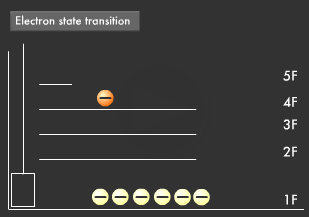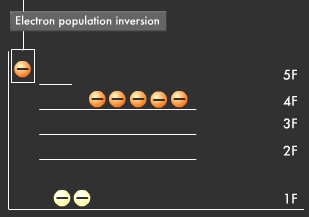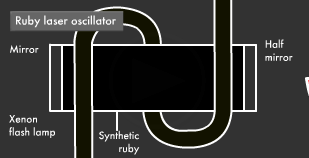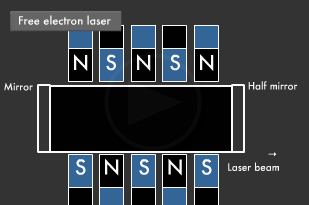Canon Science Lab
Lasers
Laser beams are another form of widely used artificial light. Let's understand the mechanism of the laser beam, one of the most crucial inventions of the 20th century.
The laser beam was discovered in 1960. The term laser is an acronym for "light amplification by stimulated emission of radiation." Lasers are a form of artificial light with uniform direction, phase and wavelength, and they are produced by precisely controlling the excited and ground states of electrons. Unlike other forms of light that do not have uniform wavelength and phase, lasers can create intense light spots from faint light sources and are thus one of the most important forms of artificial light. Lasers are currently used in all manner of applications, from the more obvious CD-ROM drives, fiber optics and other industrial products, to others such as the medical field and entertainment.
Electron Distribution Produces Laser Beams
The atoms and molecules in substances emit light (electromagnetic waves) when one of their electrons falls back down to the outermost orbit after receiving external energy and jumping to a higher orbit (energy level). This is called "spontaneous emission." Related terms include excited, which means jumping to a higher energy level and ground, which refers to the original energy state.

Let's compare this distribution process to an elevator in a five-story building. Think of the first floor as ground state and the fifth floor as excited state. When energy is applied, the elevator goes straight to the fifth floor, where its passenger (electron) gets off. However, the fifth floor is too small and unstable for many to stay for long periods of time, so most electrons go down to the fourth floor. The fourth floor is the "metastable state." Electrons can stay longer on the forth floor than on the fifth floor, but most return to the first floor (ground state), emitting energy. As you can see in the diagram below, we end up with a distribution in which most electrons are on the first floor (ground state) while only a few are on the fourth floor (metastable state).
What do you suppose would happen if we continuously applied energy to the elevator? Electrons would ride the elevator one after the other directly to the fifth floor (excited state) and then go down to the fourth floor (metastable state) where they would accumulate. This results in the phenomenon called population inversion, in which more electrons end up on the fourth floor (metastable state) than on the first floor (ground state).

However, since the fourth floor (metastable state) is not completely stable, one electron in the population inversion goes down to the first floor (ground state), releasing energy in the process and causing others to surge back to the first floor. This kind of energy release is called "stimulated emission," and this phenomenon is the means through which laser beams are produced.
Mechanism by Which Light Is Oscillated/Amplified
The light obtained through stimulated emission travels in all four directions. Its wavelength is uniform, but its phase is not. Guiding this light into a tube with mirrors at either end (one of which is a translucent half mirror), where it reflects back and forth a number of times, causes only light with uniform phase and direction to intensify and remain.

This results in a beam of "coherent light" that has a fully uniform wavelength and phase, and easily interferes with another beam of coherent light. When the intensity of coherent light rises above a certain level, it penetrates the half mirror to reach the outside. This is known as a laser beam. A variety of materials are used for lasers. When a ruby is used, yellowish-green and blue light rise to the fifth floor (excited state) and then emit red light with a wavelength of 694 nanometers when returning from the fourth floor to the first floor (ground state), thereby producing a red laser beam. Semiconductor lasers use a diode combining p-type and n-type silicon.
Mechanism of a Free Electron Laser
The laser principle we have discussed thus far applies to what is called a three-level laser. The disadvantage of such lasers is that the material they use limits the wavelength of light they can produce. There are lasers such as the free electron laser, one example of lasers that can produce laser beams in a specific wavelength. Free electron lasers make use of the phenomenon in which electrons traveling straight near the speed of light will release light if their course takes a sudden turn.

If you place magnets with their north and south poles facing each other, and then fire in an electron at high speed as shown in the diagram below, the electron emits light while winding at the mercy of the magnetic field. Amplifying the movement of electrons between the mirrors produces a laser beam. A laser beam's wavelength can be varied by changing the energy of the electrons fired in, thus enabling every kind of laser beam, from microwave to ultraviolet lasers.
